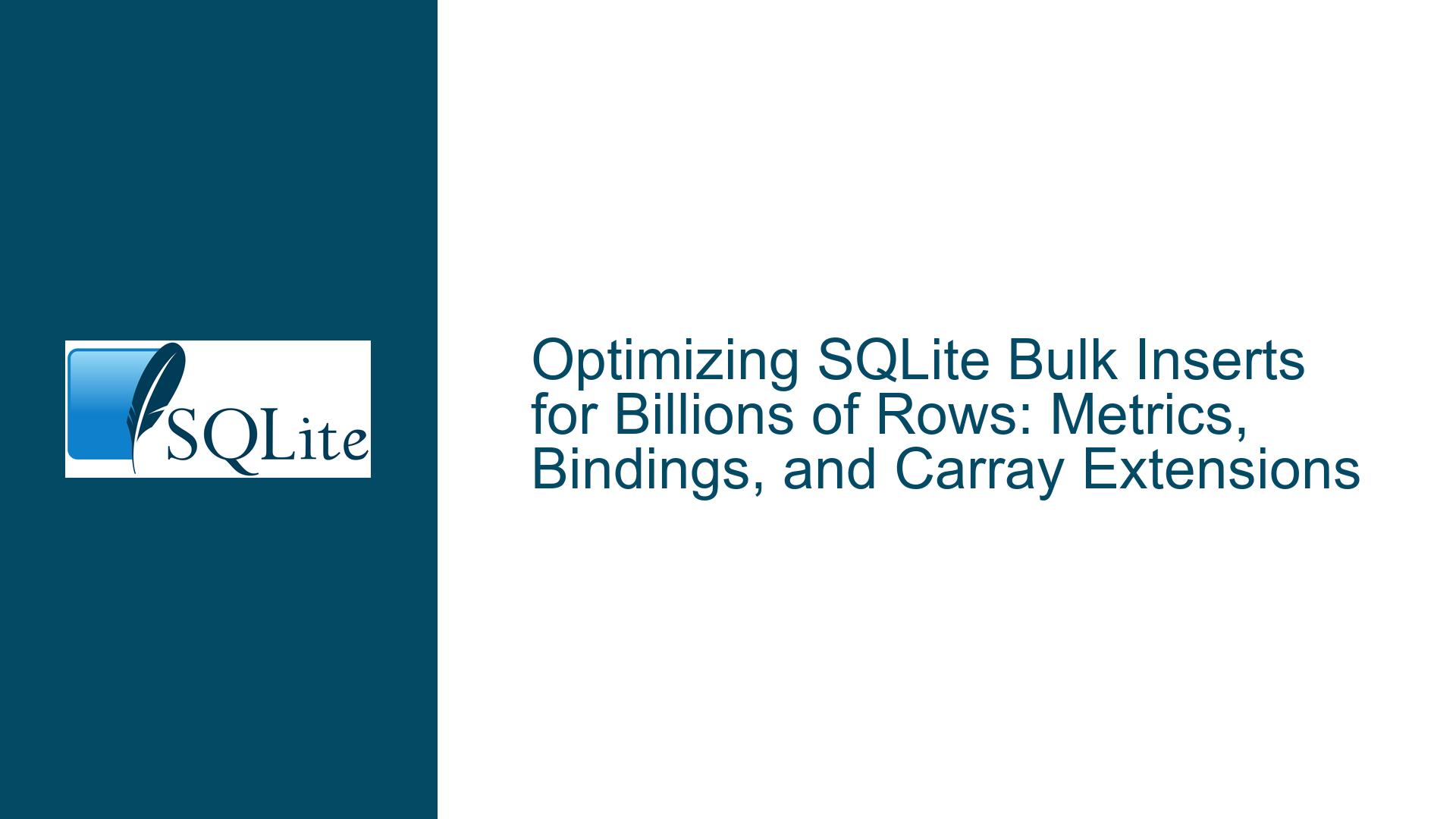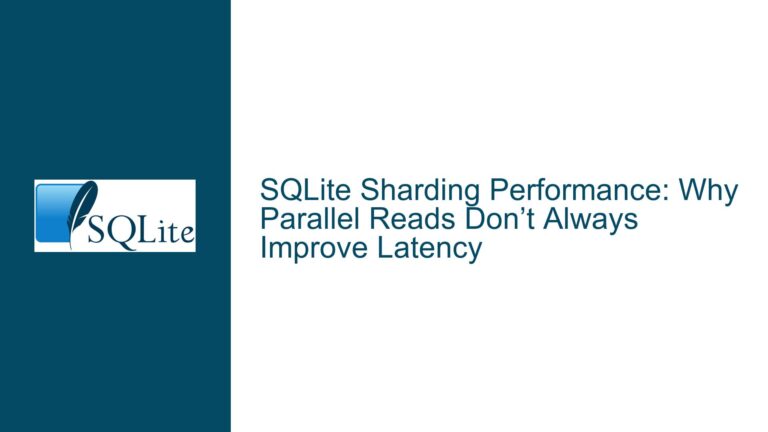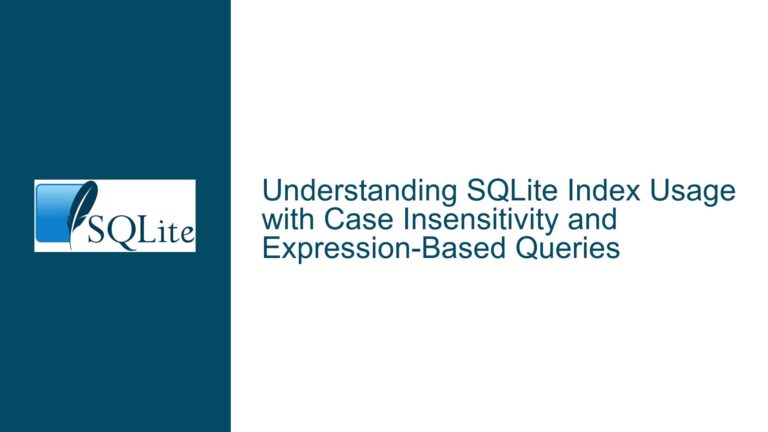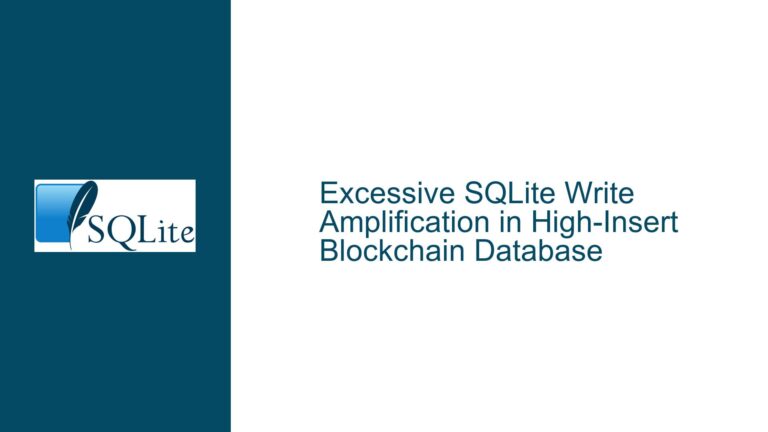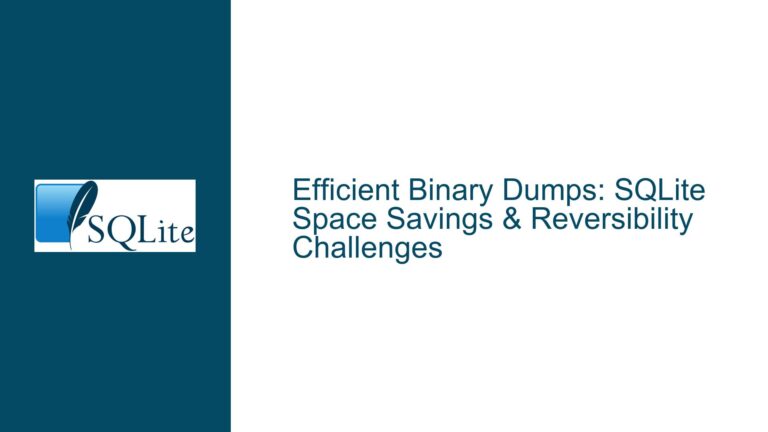Optimizing SQLite Bulk Inserts for Billions of Rows: Metrics, Bindings, and Carray Extensions
Issue Overview: Discrepancies in Insert Speed Metrics and Binding Techniques
The challenge of efficiently inserting billions of rows into SQLite databases revolves around three interrelated factors: metric selection for performance evaluation, data binding modes, and module extensibility for advanced indexing.
The Rows/sec vs. MB/sec Debate
A common misconception in benchmarking SQLite insert operations is the use of rows per second (rows/sec) as the sole metric. This metric becomes unreliable when rows contain variable-length data types (e.g., integers stored as varints, TEXT, or BLOB). For example, inserting 1 million rows with 4-byte integers yields a different storage footprint compared to 1 million rows with 100-byte strings. The article in question uses rows/sec to claim performance improvements of 2× or more, but this overlooks the actual byte-level throughput and the effects of SQLite’s page layout, varint encoding, and header overhead. A more accurate metric is megabytes per second (MB/sec), calculated either from the in-memory size of the data or the final database file size.
Transient vs. Non-Transient Data Binding
SQLite’s C API allows binding parameters in transient (SQLITE_TRANSIENT) or non-transient (SQLITE_STATIC) modes. Transient mode forces SQLite to create internal copies of TEXT or BLOB data, which introduces overhead when handling large datasets. Non-transient mode assumes the application retains ownership of the data buffer until the query completes, eliminating redundant memory operations. The original article’s synthetic benchmarks likely used small, fixed-size rows where transient binding overhead was negligible. However, real-world scenarios involving multi-gigabyte BLOB fields would see significant performance degradation if transient mode is used unnecessarily.
Carray Module and Rowid Indexing Limitations
The carray SQLite extension module allows binding C-language arrays to SQL parameters, enabling bulk inserts without iterative parameter binding. However, it lacks native support for rowid-based indexing, which limits its utility for scenarios requiring direct rowid manipulation. For instance, applications that rely on rowid for fast lookups or cross-table references must manually map external data to rowids, adding computational overhead. Extending carray to handle rowid indexing would require modifying its virtual table implementation to expose rowid mappings or integrate with SQLite’s internal rowid management.
Potential Bottlenecks: Metric Misinterpretation, Binding Modes, and Carray Limitations
Misleading Rows/sec Metrics in Synthetic Benchmarks
When rows contain small, fixed-size fields (e.g., integers), rows/sec metrics inflate perceived performance. SQLite’s varint encoding compresses integers into 1–9 bytes depending on magnitude, making the on-disk size variable. A benchmark inserting 10 million 4-byte integers might report 500,000 rows/sec, but the actual disk I/O throughput could be just 20 MB/sec (10M rows × 2 bytes/varint ÷ 1M bytes/MB). If another test uses 8-byte integers, the same rows/sec rate would imply 80 MB/sec—a 4× difference in storage efficiency masked by the rows/sec metric.
Transient Binding Overhead for Large Data Types
Applications inserting large TEXT or BLOB values (e.g., documents, images) suffer performance penalties when using transient binding. For example, binding a 10 MB BLOB in transient mode forces SQLite to allocate and copy the entire buffer, even if the application could guarantee the buffer’s lifetime. This redundancy becomes critical at scale: inserting 100 such blobs would waste 1 GB of memory bandwidth. Non-transient binding avoids this by assuming the application manages buffer lifetimes, but requires careful synchronization to prevent use-after-free errors.
Carray Module’s Rowid Handling Gap
The carray module binds arrays to virtual tables, enabling queries like:
SELECT * FROM carray(?1, ?2) WHERE rowid = 5;
However, it does not allow users to explicitly set or retrieve rowids during bulk inserts. Consider a scenario where an external array of sensor data must be inserted into SQLite with rowids matching the sensor’s internal timestamps. Without native rowid support, the application must first insert data and then update rowids in a separate pass, doubling the I/O operations.
Resolving Insert Performance: Calibrating Metrics, Optimizing Bindings, and Module Extensions
Step 1: Adopt MB/sec for Realistic Throughput Analysis
To measure insert performance accurately:
- Pre-Insert Calculation: Compute the in-memory size of the dataset. For a list of integers, sum the sizes of each value after varint encoding (e.g., 255 → 1 byte, 256 → 2 bytes).
- Post-Insert Validation: Compare the database file size before and after inserts. Use
PRAGMA page_count;andPRAGMA page_size;to compute total bytes written. - Derive MB/sec: Divide the total bytes by the insert duration. For example, a 1 GB file created in 10 seconds equals 100 MB/sec.
Example Workflow:
-- Enable file size tracking
PRAGMA main.page_size = 4096;
BEGIN;
-- Insert data
COMMIT;
SELECT (page_count * page_size) / (1024 * 1024) AS size_mb FROM pragma_page_count(), pragma_page_size();
Step 2: Implement Non-Transient Binding for Large Data
To eliminate redundant data copies:
- Use SQLITE_STATIC for Fixed Buffers: When the application retains ownership of a buffer (e.g., a preallocated
BLOBarray), bind it withsqlite3_bind_blob(..., SQLITE_STATIC). - Use SQLITE_TRANSIENT for Temporary Buffers: If the buffer is temporary (e.g., a stack-allocated string), use
SQLITE_TRANSIENTto let SQLite manage the copy.
Code Example:
// Non-transient binding for a persistent buffer
const char* persistent_text = "Large text value...";
sqlite3_stmt* stmt;
sqlite3_prepare_v2(db, "INSERT INTO tbl(text) VALUES (?1)", -1, &stmt, NULL);
sqlite3_bind_text(stmt, 1, persistent_text, -1, SQLITE_STATIC);
sqlite3_step(stmt);
Step 3: Extend Carray for Rowid Indexing
To enable rowid-aware bulk inserts via carray:
- Modify the Carray Virtual Table: Add a
rowidcolumn to the virtual table schema and populate it during array binding. - Leverage SQLite’s Virtual Table API: Implement the
xRowidmethod to return custom rowids.
Sample Modification to Carray Source:
// In carray.c, modify the xBestIndex method to handle rowid
static int carrayxBestIndex(sqlite3_vtab *tab, sqlite3_index_info *pIdxInfo) {
// ... existing code ...
// Add support for rowid filtering
for (int i = 0; i < pIdxInfo->nConstraint; i++) {
if (pIdxInfo->aConstraint[i].iColumn == -1 /* rowid */) {
pIdxInfo->aConstraintUsage[i].argvIndex = 1;
pIdxInfo->aConstraintUsage[i].omit = 1;
}
}
return SQLITE_OK;
}
Usage After Extension:
-- Insert data with explicit rowids
INSERT INTO main_table(rowid, data)
SELECT rowid, value FROM carray(?1, ?2, 'rowid:timestamps');
Step 4: Batch Inserts and Transaction Management
Even with optimal binding and metrics, failing to batch inserts within transactions can degrade performance. SQLite defaults to auto-commit mode, which wraps each INSERT in a transaction. For bulk operations:
- Explicit Transactions: Wrap inserts in
BEGIN;andCOMMIT;. - Batch Size Tuning: Experiment with batch sizes (e.g., 10,000 rows per transaction) to balance memory usage and lock contention.
Example:
import sqlite3
db = sqlite3.connect('bulk.db')
db.execute("BEGIN")
try:
chunk = [...] # List of 10,000 rows
db.executemany("INSERT INTO data VALUES (?, ?)", chunk)
db.commit()
except:
db.rollback()
Step 5: Schema Optimization for Write-Only Workloads
For write-heavy workloads:
- Disable Journaling: Use
PRAGMA journal_mode = OFF;to avoid write-ahead log (WAL) overhead. Warning: Risk of corruption on crash. - Increase Page Size: Larger pages (e.g., 8192 bytes) reduce header overhead. Set via
PRAGMA page_size = 8192;before creating tables. - Delay Index Creation: Build indexes after inserting data to avoid incremental update costs.
This guide provides a comprehensive approach to diagnosing and resolving SQLite bulk insert bottlenecks, emphasizing metric accuracy, binding modes, and module extensibility. By calibrating measurements to MB/sec, adopting non-transient binding, and extending tools like carray, developers can achieve near-linear scalability for billion-row datasets.
